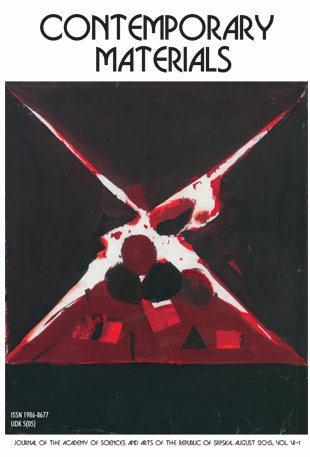DIELECTRIC SENSITIZATION OF ZEOLITIC IMIDAZOLATE FRAMEWORK-8 (ZIF-8) NANOPOWDER
DOI:
https://doi.org/10.7251/COMEN1702180LAbstract
Metallo-organic complexes are a class of materials that are increasingly used in sensory applications. Zeolitic imidazolate frameworks (ZIFs) are their subclass that are topologically isomorphic with zeolites. The porosity of the crystals and their chemical structure, as well as their thermal and chemical stability, make some of these materials (ZIFs) very suitable for making sensors. The large specific area of micro and nano particles is an important parameter for sensor applications. Despite the fact that the dielectric characterization of powders in the RF domain was neglected in scientific works, this method can have great practical importance. This paper presents the results of the dielectric characterization of the ZIF-8 nanopowder in the frequency range of 24 Hz to 24 KHz. The results indicate that the presence of evaporation of water, ethanol and methanol leads to major changes in the dielectric permittivity of ZIF-8 nanopowder.
References
D. Dudić and A. S. Luyt, Monolayer polymer photo cells - The opportunities, Contemporary Materials VI−2 (2015) 218−223.
T. R. Cook, Y-R. Zheng and P. J. Stang, Metal-Organic Frameworks and Self-Assembled Supramolecular Coordination Complexes: Comparing and Contrasting the Design, Synthesis and Functionality of Metal-Organic Materials, Chem. Rev., Vol. 113 (2013) 734–777.
J. Lei, R. Qian, P. Ling, L. Cui and H. Ju, Design and sensing applications of metal–organic framework composites, Trends in Analytical Chemistry, Vol. 58 (2014) 71–78.
W. Zhan, et all., Semiconduc-tor@Metal.Organic Framework Core Shell Heterostructures: A Case of ZnO@ZIF.8 Nanorods with Selective Photoelectrochemical Response, J. Am. Chem. Soc., Vol. 135 (2013) 1926−1933.
S. Park, et all., The polymeric upper bound for N2/NF3 separation and beyond ZIF-8 containing mixed matrix membranes, Journal of Membrane Science, Vol. 486 (2015) 29–39.
C-W. Tsai and E. H.G. Langner, The effect of synthesis temperature on the particle size of nano-ZIF-8, Microporous and Mesoporous Materials, Vol. 221 (2016) 8−13.
